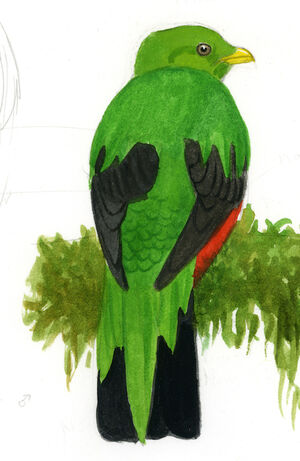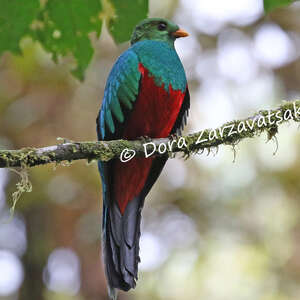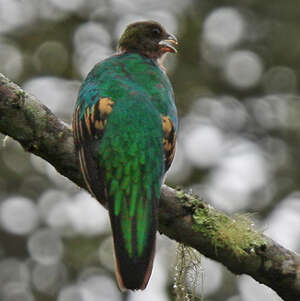Golden-headed Quetzal
Pharomachrus auriceps - Quetzal doré
Identification
The Golden-headed Quetzal, which is closer to the literal Latin translation and which our English neighbours have translated as Golden-headed Quetzal, probably forms a superspecies with the Pavonine Quetzal, which has a red beak and the female of which has bars on its lower rectrices. Dimorphism is pronounced in the species like in many trogonids. The male is a large bird, 33-36 cm without its tail of about 10 cm, and it has a strong yellow bill. The head, neck and throat are of an incredible shade of green and gold with bronze reflections. Depending on the ambient light, this head can appear golden, emerald green, bronze or copper. The eye is dark brown, almost black. The chest is emerald green with turquoise reflections, while the stomach and lower stomach are bright red. The Golden-headed Quetzal wears long and almost vertical great coverts, which are always of an emerald green shade with gold reflections. The coverts and remiges are black, the mantle and back the same emerald green as the chest but with marked blue or turquoise reflections. The bird can sometimes even appear completely blue according to the light when observed from the back. The three pairs of lower rectrices are black. Depending on its position, the green tip of the two central upper rectrices may appear and give the impression that the Golden-headed Quetzal has two leaves on the tip of its tail. When the bird is observed from the back, these two rectrices keep the greenish-gold shade of the mantle and back; the tail then appears black and green. The olive green legs are more coloured than in many trogonids. The female is paler than her mate; the cap is dark-greenish-brown, the throat and neck dark-brown, the chest with green and brown shades in its upper part and brown until the stomach which is of a duller red than the male.Its bill is brown-grey, the upper mandible can be grey. When the Golden-headed Quetzal is seen from the front, the upper rectrices of green are not seen. Juveniles resemble their mothers with a brown breast which takes on green tinges with age, the bill is black, the coverts are green without the golden reflections of adults with outer ochre-brown borders. The abdomen is more pink than red, the rectrices have white marks on a black background. There are two subspecies, Pharomacrus auriceps and ssp hargitti in the Venezuelan Andes, with a more golden colour on the head and a slightly longer tail, both subspecies are very similar and difficult to recognise, hybridisations probably take place in the meeting areas.
Subspecific information 2 subspecies
- Pharomachrus auriceps auriceps (e Panama and n Colombia to n Bolivia)
- Pharomachrus auriceps hargitti (nw Venezuela)
Foreign names
- Quetzal doré,
- Quetzal cabecidorado,
- quetzal-de-cabeça-dourada,
- Goldkopftrogon,
- aranyfejű kvézál,
- Goudkopquetzal,
- Quetzal testadorata,
- guldhuvad quetzal,
- Svarthaleketsal,
- kvesal zlatohlavý,
- kvesal zlatohlavý,
- Gyldenhovedet Quetzal,
- vuoriketsaali,
- quetzal de cap daurat,
- kwezal złotogłowy,
- Золотистоголовый квезал,
- キンガシラカザリキヌバネドリ,
- 金头绿咬鹃,
- guldhuvad quetzal,
- 金頭綠咬鵑,
Voice song and call
Habitat
He likes the altitude and it can be found between 1,200m and 3,100m along the Andes Mountain Range from Peru to Panama.
Dietfeeding habits
Reproduction nesting
During the breeding season in April in the Darien province of Panama, and from April to June along the Cordillera in Colombia, the nest of the Golden-headed Quetzal is made in a natural hole or an old woodpecker nest.
The bird can also enlarge an excavation in a decayed tree. There is no information on the reproduction of the Golden-headed Quetzal in the wild. An observation was made at the Houston Zoo in Texas early in April 1985: the couple rejected all types of nesting boxes, until the day when a vertical palm trunk with a slightly obstructed hole was put in, immediately the male started removing the leaves and fibers, and progressed by removing fibers inside the trunk. Early July, the female joined her companion in this activity, mid-August she took possession of the hole for short periods, the male remaining nearby, mid-September onwards she was hardly ever seen coming out of the nest, which was completely emptied of all fibers. The nest had been dug up to 46cm, all rough fibers removed and the bottom of the nest lined with decayed bark. Two blue-gray eggs were laid on October 25th, the incubation period was assumed to be between 17 and 20 days, the chicks were born with a one-day delay and both parents took care of the chicks, of which only one survived. It was then hand-reared by the zoo personnel, afterwards other broods were raised by the parents, the rearing period is then 24 to 30 days before the flight. It is assumed that the Golden-headed Quetzal is of two years of age when it is able to reproduce.Geographic range
Threats - protection
IUCN conservation status
concern
in the Wild
threatened
evaluated
It does not seem to be in particular danger, its preference for altitude and humid canopy protects it and makes it difficult to observe. However, the Golden-headed Quetzal is dependent on its habitat, so it is up to us not to destroy it so that we can continue to admire it.
Sources of information
- IOC World Bird List (v15.1), Gill, F and D Donsker (Eds). 2025-12-07.
- A Natural history of the Trogonidae, Joseph M.Forshaw Albert Earl Gilbert
- Vol. 6 - Handbook of the Birds of the World, Josep del Hoyo-Andrew Elliott-Jordi Sargatal
- The Birds of Panama, George R.Anger Robert Dean
- xeno-canto, Sharing bird sounds from around the world,
- Arthur Grosset's Birds, Arthur Grosset
- Avibase, Lepage Denis
- BirdLife International, BirdLife International
- Neotropical Birds Online,
- Planet of Birds,
Other sources of interest
 Specification sheet created on
30/07/2023 by Anne et Gabriel Leboff
Specification sheet created on
30/07/2023 by Anne et Gabriel LeboffTranslation by AI Oiseaux.net
© 1996-2025 Oiseaux.net
- Accipitriformes
- Aegotheliformes
- Anseriformes
- Apodiformes
- Apterygiformes
- Bucerotiformes
- Caprimulgiformes
- Cariamiformes
- Casuariiformes
- Charadriiformes
- Ciconiiformes
- Coliiformes
- Columbiformes
- Coraciiformes
- Cuculiformes
- Eurypygiformes
- Falconiformes
- Galliformes
- Gaviiformes
- Gruiformes
- Leptosomiformes
- Mesitornithiformes
- Musophagiformes
- Nyctibiiformes
- Opisthocomiformes
- Otidiformes
- Passeriformes
- Pelecaniformes
- Phaethontiformes
- Phoenicopteriformes
- Piciformes
- Podargiformes
- Podicipediformes
- Procellariiformes
- Psittaciformes
- Pterocliformes
- Rheiformes
- Sphenisciformes
- Steatornithiformes
- Strigiformes
- Struthioniformes
- Suliformes
- Tinamiformes
- Trogoniformes
































